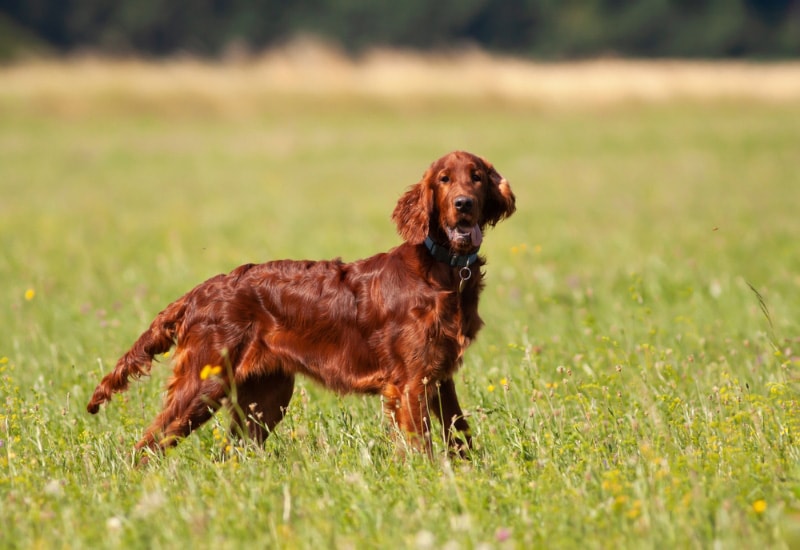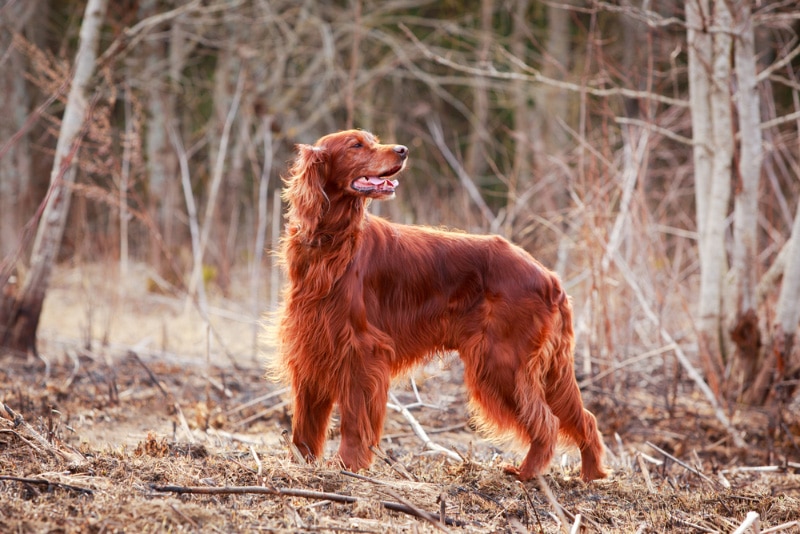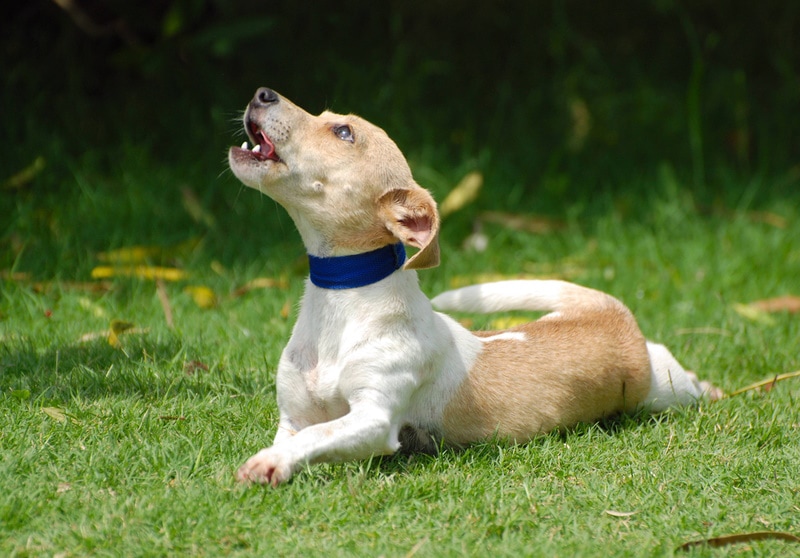Male vs. Female Irish Setter: The Key Differences (With Pictures)
By Ed Malaker
Updated on

Click to Skip Ahead
The Irish Setter is a wonderful dog that’s friendly toward family members and other pets. They are intelligent and easy to train, but many people aren’t sure whether a male or female would be more suitable for their household. If this sounds like you, keep reading as we look at the appearance, personality, training, and health of each, so you can see if any of the differences can help you decide.
Visual Differences

Being a dog with quite a long coat, it may not be immediately obvious if you are looking at a male or female setter. Although sexual dimorphism isn’t always very pronounced in dogs, there are a few ways in which the average male Irish Setter differs from the female. Let’s take a look:
At a Glance
- Average height (adult): 27 inches
- Average weight (adult): 70 pounds
- Average height (adult): 25 inches
- Average weight (adult): 60 pounds
Irish Setter 101
Irish Setters have a coat that ranges in color from chestnut or mahogany to red, and the fur is long and silky. They are energetic dogs that love to play and entertain family members, and they will always be the first in line when it’s time to leave the house. They are protective but friendly and intelligent enough to learn complex tasks easily. They enjoy being around people and become deeply attached to their families.
Male Irish Setter Overview

Personality / Character
Male Irish Setters have endless energy and love engaging in games like fetch, running, and even water play. They are known for their loyalty and devotion, often wanting to be by your side. Male Irish Setters are typically social dogs that are often friendly and approachable with strangers, but can also be stubborn and aloof. They are curious dogs that enjoy exploring their environment.
Training
Training a male Irish Setter can be a rewarding experience, but it also requires patience, consistency, and positive reinforcement techniques. Male Irish Setters are intelligent and eager to please but can also be a bit independent in their thinking. Begin training as soon as possible, and use positive reinforcement techniques to help keep them interested. Short, scheduled training sessions usually have the best results, and help get your dog into a routine that makes it easier to keep them focused.
Health & Care
Schedule regular veterinary check-ups to monitor your dog’s overall health and help ensure that they get the proper vaccinations. Regular dental visits can inform you of their dental health and enable you to discuss any questions about your pet’s health. You will also need to brush their coat several times each week, especially during the fall and spring shedding seasons, to keep them looking their best and prevent mats and tangles.
Brush your dog’s teeth regularly with pet-safe toothpaste, provide dental chews or toys, and schedule professional dental cleanings as needed to help slow the progression of dental disease, which affects many dogs. Ensure that they get plenty of mental and physical exercise to help prevent obesity and maintain overall health.

Breeding
Breeding a male Irish Setter is a significant responsibility that requires careful consideration and commitment. Regular veterinary check-ups, including hip and elbow evaluations for dysplasia and genetic screenings for inherited conditions, are crucial to confirm your dog’s suitability for breeding. They should also have a stable and desirable temperament, and you should be well acquainted with the breeding standards of the Irish Setter to help maintain the breed’s integrity.
If you are not planning to breed from your dog, you may wish to consider castration. There a numerous benefits to castration, including:
- Reduce/stop overt sexual behaviors
- Minimize urine making
- Eliminate risk of testicular cancers and perianal adenoma
- Virtually eliminate risk of benign prostatic hyperplasia (however, castration does not affect risk of prostatic cancer)
- Reduces risk of straying
- Reduces risk of dominance or aggression behaviors
- Reduces risk of being targeted by other dogs
- Reduces sexual frustration which can lead to acting out or destructive behavior
- Can help with training by removing a significant source of distraction
Most vets recommend waiting until your dog has reached adulthood/sexual maturity before castration, but this can vary depending on the breed, individual and circumstance, so talk to your vet.
- Loyal and affectionate, forming strong bonds with their owners
- Natural protectors
- Compatible with other dogs, especially when properly socialized
- High energy levels may require substantial exercise and mental stimulation
- They can exhibit destructive behavior if not adequately exercised or mentally engaged
Female Irish Setter Overview

Personality / Character
Female Irish Setters are affectionate dogs that often display nurturing tendencies toward their human family and other pets in the household. Like their male counterparts, they are exceptionally loyal and devoted to their owners and often form strong bonds with them. While they can be slightly less exuberant than male Irish Setters, they still thrive on exercise and playtime.
Training
Training a female Irish Setter shares many similarities with training her male counterpart. Female Irish Setters are intelligent, affectionate, and responsive to positive reinforcement techniques, and can occasionally be hard to keep focused. Starting your training early and remaining consistent with short training sessions will usually produce the best results, and training will help keep the dog safe and well-behaved as an adult.
Health & Care
Caring for a female Irish Setter is similar to caring for her male counterpart, as they have the same needs for regular dental visits and vaccinations. You will also need to brush your dog several times each week, manually brush their teeth with dog-safe toothpaste as often as possible to slow the progression of dental disease, and ensure that they get plenty of exercise to stay healthy and happy.
Spaying is recommended for non-breeding females, with the following health benefits:
- Prevention of pregnancy and unwanted male advances
- Stopping estrus (having a season), which can be quite distressing for some dogs, with fever, inappetence and discomfort quite common
- Preventing ovarian cancer and pyometra (infection of the uterus)
- Significantly reducing risk of mammary cancer (0.5% risk if spayed before first season, 8% risk after first season, increasing from 26% risk after second season)
- Spayed females tend to feel more settled and calm
The recommendation for the timing of spaying tends to be either just before or just after their first season. In larger breeds, like the Irish Setter, there may be a stronger argument for waiting until after their first season to also reduce the risk of urinary incontinence due to the premature removal of estrogen. Talk to your vet about the best time to have your Setter spayed.

Breeding
Breeding a female Irish Setter is a significant undertaking that requires careful planning, ethical considerations, and a commitment to the welfare of the dogs and the puppies that they produce. Ensure that your female Irish Setter is in excellent health before breeding.
Get her genetically tested to screen for inherited diseases or conditions common in the breed to help you make informed decisions about the mating partner. Choose a female with a stable and desirable temperament to help ensure friendly puppies.
- Affectionate and nurturing
- Friendly and sociable with family members, strangers, and other dogs
- Prone to fewer marking and territorial behaviors compared to males
- They can exhibit destructive behavior if not adequately exercised or mentally engaged
- She may need more consideration and care during the breeding process
Which Sex Is Right for You?
The choice between a male and female Irish Setter depends on your preferences, lifestyle, and specific needs. There is no one-size-fits-all answer, as both sexes can make wonderful pets, but require plenty of exercise and have moderate grooming needs. Males are usually more playful and protective but are more likely to engage in territory marking. Females are more nurturing and adaptable to various living situations but are more independent and less likely to stay by your side.
See Also:
- Great Pyrenees Health Problems to Watch For (Vet Answer)
- Carnauzer (Cairn Terrier Schnauzer Mix): Pictures, Care Guide, Temperament & Traits
Featured Image Credit: Left: (Male Irish Setter) anetapics, Shutterstock, Right (Female Irish Setter) Svetilnikk, Shutterstock












